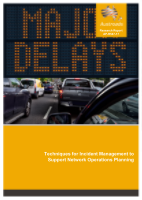Traffic Management

- Publication no: AP-R547-17
- ISBN: 978-1-925451-94-8
- Published: 26 July 2017
- PDF (free) Download
This report investigates current local and international incident management techniques and proposes an Australasian incident management framework that supports network operations planning.
A literature review highlights the fact that traffic incident management (TIM) is not only a process of managing multi-agency, multi-jurisdictional response to road traffic incidents, but also a broader management program that involves an objective setup, stakeholder collaboration, option development and selection, implementation and performance evaluation.
Baseline and emerging TIM techniques and practices for the collection of road and traffic data and the response to incident management needs were also reviewed and new and emerging techniques for traffic incident management identified.
To assist in the establishment of a harmonised TIM methodology across Australasia, an incident management framework was developed based on the leading practices and techniques. The adoption of this integrated framework, which is underpinned by seven management principles, would improve the operation and safety of the road network by reducing the impact of planned and unplanned incidents.
While the potential implications and benefits of the new technologies within the TIM framework have been briefly discussed in this report, quantifying the safety and efficiency impacts of different TIM techniques requires further investigation.
- Summary
- 1. Introduction
- 2. Literature Review
- 2.1. Baseline Traffic Incident Management Techniques
- 2.1.1. In-road Sensors
- 2.1.2. Over-road Sensors
- 2.1.3. Video Camera System
- 2.1.4. In-vehicle Sensors
- 2.2. Emerging Traffic Incident Management Techniques
- 2.2.1. Smartphones and Global Navigation Satellite Systems
- 2.2.2. Cooperative-ITS and Dedicated Short Range Communications
- 2.2.3. Social Media, Participatory Sensing and Crowdsourcing
- 2.2.4. Drones for Traffic Data and Incident Management
- 2.3. Discussion and Summary Matrix
- 3. Current Practices in Australia and New Zealand
- 3.1. New South Wales
- 3.2. New Zealand
- 3.3. Queensland
- 3.4. South Australia
- 3.5. Victoria
- 3.6. Western Australia
- 3.7. Other Jurisdictions
- 4. Contemporary Leading Practices in Australasia
- 4.1. Multi-agency Collaboration within Each Jurisdiction
- 4.2. Planning for Traffic Incident Management
- 4.3. Traffic Incident Management
- 4.3.1. Incident Detection and Verification
- 4.3.2. Response to Traffic Incidents
- 4.3.3. Traffic Management
- 4.3.4. Traveller Information
- 4.4. Performance Evaluation
- 4.5. Capability Development
- 4.6. Relevance to Network Operations Planning
- 4.7. Relevance to ‘Safe System’ Approach
- 5. Development of Traffic Incident Management Framework
- 5.1. Purpose and Objectives of the Framework
- 5.2. Traffic Incident Management Principles
- 5.3. Proposed Traffic Incident Management Framework
- 6. Conclusions and Future Research
- References
- Appendix A Austroads Project NS1017
- A.1 Overview
- A.1.1 Task 1 – Literature Review
- A.1.2 Task 2 – Current Practices
- A.1.3 Task 3 – Evaluation Framework
- A.1.4 Task 4 – Microsimulation
- A.1.5 Task 5 – Best Practices
- A.1.6 Remarks on Incident Management in 2007
- Appendix B List of Policy and Practice Documentation from Each Jurisdiction
- Appendix C Summary of Arrangements for Each Jurisdiction
